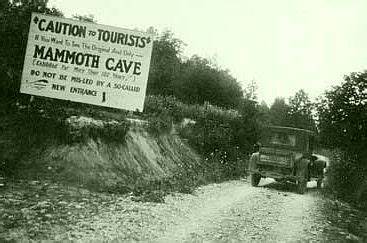Mammoth Cave was not the tourist destination that it is today. The Kentucky caves were individually owned by enterprising individuals. Between the years of 1920-1941, there was a battle for tourist dollars that included raids and destruction in some parts of the cave system.
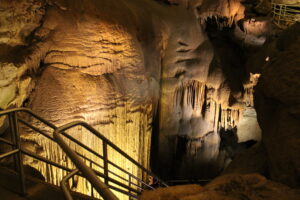
Called the Kentucky Caves at the time, they would later come under the umbrella of the Mammoth Cave system. However, these seven “show” caves would be special in their own right and start an economic war of epic proportions. They are Salts Cave, Crystal Cave, Long Cave, Short’s Cave, Colossal Cave, Great Onyx Cave, and the Indian Cave.
This was a war of economics and lawsuits, not a battle that was fought with weapons. One man would die trying to find a new cave to make money for his family. This death along with the lawsuits would lead to the national park that we have today.
Primarily in Edmonson County, the 420 miles of caves gave some unusual sites to behold. This became tempting for those who owned the land that was above the Kentucky Cave system. In 1972, it was discovered that the “show caves” and the Mammoth Cave proper, were part of the same caving system.
How the Kentucky Caves are Formed
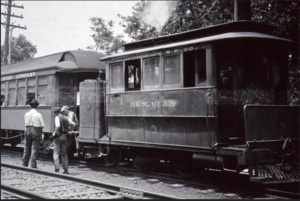
The Kentucky Caves are called “solution” caves. This happens when rainwater seeps down through the ground and bonds with carbon dioxide that came from the air and dirt. This mixing of chemicals forms a weak carbonic acid. As the water seeps between crevices in the rocks made of bedrock limestone, the weak acid begins to wear away at the rock formation. Over the years, these tunnels become larger and larger and eventually form caves.
Because the Kentucky Caves form a large system, the name Mammoth Cave was given because of the enormous size of the caves. The Mammoth Cave system is the largest to be found in the world.
Discovery of Mammoth Cave
For thousands of years, Native American people would use caves. There are many remains of these people who have been found in different caves. Sometime in the 1790s, the white pioneers in Kentucky discovered the Kentucky Caves.
Mining of the Caves
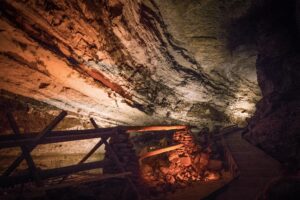
During the War of 1812, the cave was mined for saltpeter near its entrance. The Jefferson Embargo Act of 1807 stopped all foreign trade. This was disastrous for the American military. Saltpeter is one of the main ingredients used for the production of gunpowder. Calcium nitrate, also called Saltpeter, began to be mined from the Kentucky cave as the production became more lucrative on an industrial scale. When the war ended, there was no longer a large need for calcium nitrate, and so the businesses were abandoned.
The Caves Open To Tourism

In 1816, formal guided tours were given to all of those that could reach the caves. It was mostly the rich who would make the trip to the destination to explore the massive cave system. For 125 years, the caves would be broken up between different individual families. Competition for the tourist dollars became intense as many points of interest would pop up along the wagon roadways to attract people to see the caves.
.
.
Marketing Ploys
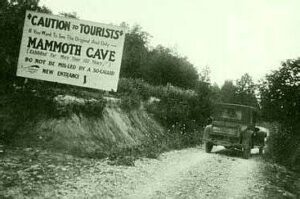
Throughout the 1800s, the land would change hands several times. Each time a new owner would take possession of the land, they would have a new clever marketing strategy to employ. Some of these tactics would cause damage to the caves. From cave mummies to houses inside the caves, no marketing ploy was too fantastic to use.
.
.
Fawn Hoof
Due to the sensitivity of the photographs and out of respect for the American Native Tribes and their people we have chosen not to use the pictures of Fawn Hoof. These photographs are too graphic in nature for viewing in our humble opinion.
As one of the marketing strategies, one of the owners came up with an interesting plan. Gaining access to a mummified Native American from another location in the cave, which was displayed in another part of the caves as “Fawn Hoof”.
The body was found by miners in 1811. The body was wrapped in two deer skins and a woven woolen blanket. The mummy also had elaborate jewelry and various tools. It was claimed that the mummy was a woman, however, the mummy is estimated to be over six feet tall with short hair and makeup on its lips. Whatever the sex of the mummy, the person must have held a high status to be buried in such a manner.
This mummy was passed from collector to collector and fell into disrepair and neglect. Eventually, in 1876, the mummy was transferred to the Smithsonian Institution.
Tourist Damages
One of the saddest parts of this whole conflict is how much damage was inflicted on the Kentucky Caves. Tourists were encouraged to break off pieces of the rock formations as souvenirs. Still, others were encouraged to smoke in the caves. While other tourists touched the rock formations which harms the growth of the rocks.
Road Sign War
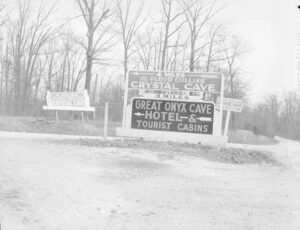
As more and more tourists began to flock to the famous Mammoth Cave, the entrance owners got creative. To divert the tourist to their sites, they would put up huge road signs advertising their caves.
This began to get ugly as people began competing for these same tourists and began to destroy or steal the signs. Ticket offices were often burned to the ground to keep people away from other caves. Sometimes there would be violent attacks upon competing families to keep them from making more money than anyone else.
The Misdirection of the False Police
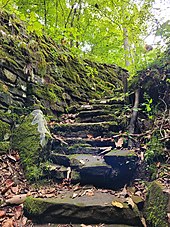
Again, no idea or ploy was overlooked when it came to the competition for the almighty tourist dollar. There were some enterprising folks that decided to throw up road signs to misdirect people to come to their personal entrance to the Kentucky Caves.
They would throw up roadblocks or would have people dress up as police officers, they were called “cappers”, to direct people to their caves. Such excuses for these road signs included road closures due to flood water, cave-ins, or other excuses. These “cappers’ would also sabotage each other’s road signs.
The “officers” would then offer tickets to be sold to alternative entrances to different caves. Many people were fooled into thinking that these dressed-up people were either traffic cops or police officers.
This became such a huge problem that businesses would put up signs along the road which read: “DO NOT BE CONFUSED – NO ONE HAS THE RIGHT TO STOP YOU ON THIS ROAD.”
Cure for Consumption

One of the saddest ploys of the Kentucky Caves’ history record would be the cottages that were built. These cottages were built to help those that were suffering from consumption, tuberculosis, and other lung diseases.
In 1839, Dr. John Croghan of Louisville, Kentucky, was diagnosed with tuberculosis. To help find a cure for this fatal disease, Dr. Croghan purchased a part of the Kentucky Caves for $10,000. He had cottages built for those who would come to the cave for its “restorative” properties.
Sixteen patients would go under the care of Dr. Croghan in hopes of a cure. This idea did not work as the damp cave conditions worsened their symptoms and all of those who came for help would die of their diseases.
Clever Names for Caves
There were several people that decided to use clever names for the entrances to attract tourists. Such names as Salt Cave and Colossal Cave were among the most popular. Other businesses named their caves Oynx Cave, and Diamond Cave, or just stole the name Mammoth to add to their name. Such examples are Morrison’s New Entrance to Mammoth Cave or Mammoth Oynx Cave. There was also the Great Crystal Cave.
Floyd Collins
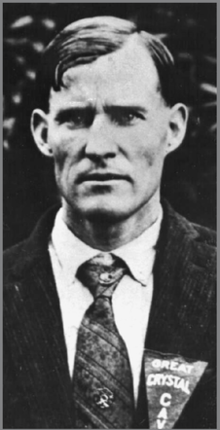
By 1920, the competition for the Kentucky Caves had grown to epic proportions. There were constant hunts for new caves for exploitation. This became the fatal mixture that lead to the only death of this war.
The Collins family owned the entrance to the Great Crystal Cave. Because this cave was off of the main road, and due to all of the ploys from the other families, the Great Crystal Cave was not visited very often. Thirty-eight-year-old William Floyd Collins decided that he was going to go cave exploring for a better cave for his family to use to make money. Collins had left word with his family on where he was going and what he was about to attempt.
.
.
.
.
Exploring a New Cave
Taking a lantern and a rope, Collins entered a hole that was just big enough for his body. He wiggled his way for several feet down a chute until he came to a large cave. He explored the room until his lantern began to flicker. He then began to climb his way back into the hole and wiggle his way back up in which he had just come out.
Just as he was about to reach the top of the small hole, Floyd Collins had become stuck in the chute. A small rock had dislodged and it wedged Collins’s body inside of the chute with him unable to move. The more Collins tried to move from his position the more rocks and dirt began to fill the space around him. Collins could not see the exit as the chute had several sharp zig-zag turns.
Rescue Attempts
When Collins did not show up later that evening, the concerned family began to hunt for him. The next day he was found by the sounds of his screams for help. The smallest of the party crawled into the cave to access the situation. It looked hopeless. The first attempts at rescue failed.
Within 48 hours the predicament that Collins was in now made national headlines across the United States. Within ten days, the National Guard had to be called in because of the media circus and vendors selling wares to thousands of people who came for the spectacle.
Because the chute was so fragile, the Lt. Governor thirteen days later ordered and supervised the hand drilling of a rescue shaft. While the shaft was being drilled, Skeets Miller, Floyd’s brothers, and other small cavers made several trips into the small chute to help try to keep Floyd alive.
On the fourth day, a small cave-in happened and a rock collapsed the entrance to the passageway. The men were able to keep voice contact with Floyd during that time. For two weeks, Floyd was stuck in this chute.
What Happened After
The miners finally reached Floyd Collins on Day 16. Unfortunately, it was too late, Collins had died before rescue. His death happened three days before they reached him. He died of exposure through hypothermia, thirst, and hunger. It took a further two months to recover his body.
The grieving Collins family sold their Great Crystal cave to another person. This person was not one to let a tragedy go to waste. So, they took the body of Floyd Collins and displayed it in the cave inside of a glass coffin. His body was stolen on the night of March 18-19, 1929, and was later recovered with a leg missing. The remains were kept in the cave in a chained casket after that point.
After the Mammoth Cave park took ownership of the cave, the family requested a burial for Floyd. This was granted. Floyd is now interred at the Cave Baptist Church Cemetery, on Mammoth Cave Park grounds. His tombstone reads “Greatest Cave Explorer Ever Known”.
The solution to the Wars?
Because of the intense actions of the people who were trying to cash in on the Kentucky caves, there came a movement to make a national park.
In 1924, the Mammoth Cave National Park Association was established. Authorization for the park was approved on May 25, 1926. Using donated funds, the Association began to buy farmlands around the Kentucky caves. However, this did cause some legal issues.
The death of Collins only added to this movement as it was thought that a national park and consolidating the caves would stop any further deaths related to the conflict.
Law Suits and Legalities
![The Washington times. [volume], March 25, 1929, Page 12, Image 12](http://kytnliving.com/wp-content/uploads/2022/11/Image-12-91x300.png)
The federal government was prohibited from restoring or developing any land that was held by the Mammoth Cave National Park Association because it was a private entity.
The Evening Star reports on March 24, 1929, that the heirs of the original owner of the property asked for funds as the Mammoth Cave Park plans were advancing. The heirs were from the Dr. John Cooghan estate.
This suit was filed with the District of Columbia Supreme Court to stop the Mammoth Cave trust estate from permitting the Mammoth Cave National Park Association from taking the property without paying for it. The heirs were not opposed to the park but requested fair compensation for the land that was on the block to be taken by the Mammoth Cave trust estate.
Mammoth Cave National Park Formed
The private Mammoth Cave became a National Park in 1941. However, this did not immediately end the war or set up a truce among the families. It took several decades for many of the businesses to close doors or to become incorporated into Mammoth Cave Park.
By 1960, the remaining businesses felt that they needed to cooperate and cross-promote the caves. The information booths and cappers began to disappear from sight as more and more cooperation ensued.
Renaming and World Treasure
In 1972, Mammoth Cave united with the Flint Ridge system to become the official name of the Mammoth-Flint Ridge Cave System. The National Park became a World Heritage site on October 27, 1981. The Park went on to become an international Biosphere Reserve on September 26, 1990. And finally, an International Dark Sky Park on October 28, 2021.
Thank You
We at Kentucky Tennessee Living want to thank you for watching and reading our articles. Don’t forget to hit that like button as the more likes we receive the more likely YouTube is to suggest our videos to other viewers. Also, to receive notice when we upload a new video be sure to subscribe and click the bell notification.
We thank you for continuing to support Kentucky Tennessee Living. As we bring to you the history of the Appalachian Mountains.
Source Information
The Mysterious Story Behind the Fawn Hoof Mummy and its ‘Ancient Egyptian Connection’
https://curiosmos.com/the-mysterious-story-behind-the-fawn-hoof-mummy-and-its-ancient-egyptian-connection/
Tuberculosis in Mammoth Cave
https://www.nps.gov/articles/tuberculosis-mammoth-cave.htm
The Washington herald. [volume]
(Washington, D.C.), 06 June 1920.
Chronicling America: Historic American Newspapers. Lib. of Congress.
https://chroniclingamerica.loc.gov
Chronicling America: Historic American Newspapers. Lib. of Congress.
https://chroniclingamerica.loc.gov
Image 14
Evening star. [volume], March 24, 1929, Page 14, Image 14
Image 12
The Washington times. [volume], March 25, 1929, Page 12, Image 12
Floyd Collins
https://en.wikipedia.org/wiki/Floyd_Collins
The Tragedy of History’s Smallest Underground War
https://skeptoid.com/blog/2014/09/26/undergound-war/
Kentucky Cave Wars
https://showcaves.com/english/explain/History/KentuckyCaveWars.html
The Kentucky Cave Wars
https://www.appalachianhistory.net/2017/04/kentucky-cave-wars.html
The Kentucky Cave Wars
https://www.nps.gov/articles/000/the-kentucky-cave-wars.htm
Kentucky Cave Wars
https://showcaves.com/english/explain/History/KentuckyCaveWars.html
Mammoth Cave National Park
https://en.wikipedia.org/wiki/Mammoth_Cave_National_Park
Copyright and Other Information
All photos are in the public domain unless otherwise noted. This includes photos dated before 1923. All other photos are used with permission or under the education fair use statute of the US copyright law.
Copyright 2022 Kentucky Tennessee Living
kytnliving.com/copyright-2/
Social Media Pages
For more about us, you can visit our Facebook page:
https://www.facebook.com/kytnliving
Our Twitter page:
https://www.twitter.com/KYTNLiving
Our YouTube Channel:
https://www.youtube.com/kytnliving
When we forget our past and who we are as a people, then we become who “they” say we are. ~~ David Sergent
I have attended the University of Kentucky. I have an Associates Degree from Hazard Community College and Technical School. I have also attended the University of Pikeville. I have taken several classes in Journalism as well as in the Appalachian History, Literature, and Sociology during my time at those schools.
I was born in Florida and grew up in Burdine, Kentucky. I have been married to David W. Sergent since May 4, 2013. I have two children and four grandchildren from a previous marriage. I currently live in Tennessee but my hope is to one day come back home to live in the beautiful mountains once more.


